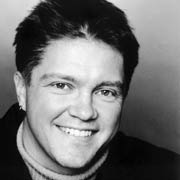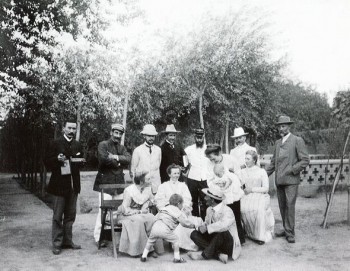Author: Anna-Leena Nissilä
Tough cookies
30 March 2008 | Authors, Interviews
Aino Havukainen and Sami Toivonen’s quirky duo Tatu and Patu delight readers of all ages. Interview by Anna-Leena Ekroos
Once upon a time there were two remarkably round-headed, thin-haired brothers. They were named Tatu and Patu and their principal personal attributes were curiosity and adventurousness. In the boys’s hometown of Outola (‘Oddsville’), things were done a little differently from around here. So when the boys leave their stomping grounds on an expedition into our world, perplexity and amusing situations ensue. More…
Classroom capers
30 December 2006 | Authors, Interviews

Timo Parvela
According to a celebrated 2003 report, Finnish schoolchildren emerged as world leaders in mathematics, science, literacy and problem-solving. In his books for children, the writer Timo Parvela, himself a former teacher, reveals a keen understanding of the mayhem that must lie behind such assessments. Interview by Anna-Leena Ekroos
Timo Parvela (born 1964) has received a particularly enthusiastic response to his Ella series for primary school-aged readers. Parvela has written picture books, CD-Rom scripts, books for young people and scripts for television and radio. His popular Ella series records the adventures of second-grader Ella and companions, including Pate, the headteacher’s son who’s fond of disguises, Tuukka, the young genius, Samppa, the copious weeper, and the pugnacious Buster. The gang of kids means well, but somehow, through misunderstandings, things always end in chaos. More…
Male parole
30 June 2006 | Authors, Interviews

Hannu Luntiala. Photo: Jukka Uotila
In his first collection of short stories Hannu Luntiala reinvents the form to examine the lives of 16 men. One story consists of just one long sentence; another is written in the made-up ‘Katalanian’ language; a third omits all the commas
A successful IT boss; a humble Greek Orthodox monk; an old man lying like a vegetable hooked up to a life-support machine. Hannu Luntiala’s collection of short stories presents us with sixteen men’s emotional landscapes. Entitled Hommes, the collection is the debut by Hannu Luntiala (born 1952).
Variety is to be found not only in the characters themselves, but in the language and style of each of Luntiala’s stories. For him language is an integral part of the story; it can open up new perspectives that a simple plot cannot. More…
An officer and a gentleman
Issue 4/2004 | Archives online, Authors, Reviews

A moment in the Chinese garden: from left, Eric Macartney. Kashgar, China, 1906. Photo: C.G.E. Mannerheim
A photograph from 1906 prompted Markus Nummi to write a 500-page novel about the people of the caravan route in China. One of his characters, the Finnish photographer and spy-explorer Carl Gustaf Mannerheim, in reality later became Finland’s sixth president. Where does fiction end and history begin? Anna-Leena Nissilä investigates
The city of Kashgar in Chinese Turkestan in the year 1906: a group of French explorers and a crowd of Swedish missionaries from the local province, along with other members of the European community and their children, have gathered together in an orchard to take a picture. Midilimanglar, keep still, says the photographer, Baron Carl Gustaf Mannerheim, and presses the shutter release. The admonition is without effect; the picture turns out restless. Little Eric can’t hold still; a baby girl is grabbing at a man’s hat; the adults are looking past the camera. For some reason the host of the event, an Englishman named Macartney, is standing a pace away from the rest of the group.
Almost a century later, the author Markus Nummi (born 1959) runs across Mannerheim’s snapshot and becomes inspired. He tells how the expansive and thematically wide-ranging historical novel Kiinalainen puutarha (‘The Chinese garden’, Otava, 2004) began to form around the photograph:
‘The photograph is the starting point for everything, the intersection and blink of an eye in which all of my story’s central characters are close to another. I was fascinated by the picture’s bustle: people looking every which way, all the fumbling about. And when you look at the picture more closely, you start to see different kinds of connections; when you look at where these people were coming from and where they went in their lives, you can start to imagine what is hidden behind the picture. I started to contemplate what the photographer saw at the moment the picture was taken, maybe angels?’ More…
From Haifa to Helsinki
Issue 1/2004 | Archives online, Authors, Interviews, Reviews
Born into a Palestinian Christian family in Israel, the journalist Umayya Abu-Hanna has just published a prize-winning autobiographical novel – in Finnish. Here, she tells Anna-Leena Nissilä about life on the outside
In Haifa, Israel, in the 1960s and 1970s, a little girl whose wild, curly hair will not obey a comb is growing up. She is the oldest of three children in a Christian Palestinian family; her father is a rector and poet, her mother a pharmacist and a convinced feminist. Both are solidly leftwing. At home Arabic and English are spoken interchangeably; the children pick up Hebrew on the street. When their education at a Catholic convent begins, Italian and French are added to their languages. More…
-
About the author
Anna-Leena Nissilä (née Ekroos, born 1968) is a journalist and literary critic who lives in Vaasa.
© Writers and translators. Anyone wishing to make use of material published on this website should apply to the Editors.
